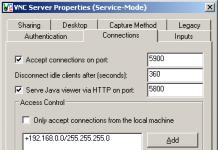This article contains the most common errors when starting Windows 10, as well as how to fix them. We hope this information will make life a little easier for those who switched to a new version of the system and suddenly found themselves between a rock and a hard place.
1. Windows 10: “The computer is not starting correctly”
The first common problem when starting Windows 10 is that the system reports some critical error ( CRITICAL_PROCESS_DIED, INACCESSIBLE_BOOT_DEVICE), and then displays a blue "Automatic Repair" screen with the text .
 Automatic recovery: the computer did not start correctly
Automatic recovery: the computer did not start correctly The cause of this error, in most cases, is damage and deletion of system files or registry entries. This may be caused by installing and uninstalling programs, or by antivirus programs or Windows registry cleaning utilities.
The solution to the problem is to repair files and registry entries that are damaged:
- Click on the button Extra options on the blue screen, select Troubleshooting> Extra options > Boot Options.
- Click Reboot.
- In the window Boot Options Press the F6 key or number 6 on the numeric keypad to launch Safe Mode with command line support.
- The computer will restart in Safe Mode and Command Prompt will automatically open. In it enter:
The computer will restart and after that Windows will start in normal mode.
2. Windows 10 does not load beyond the logo
Another known problem is that the system boots all the way to the Windows logo, after which the computer randomly shuts down. The reason for this error is also damage to system files, however, unlike the first case, the damage is so serious that the system cannot start the recovery itself.
In this case, you will have to create a Windows emergency recovery disk on another Windows 10 PC:
- In the Windows 10 Control Panel, find and select Recovery > Creating a recovery disc.
- In the window that appears, set the parameter Back up system files to a recovery drive and press Dalley.
- Connect an empty USB drive to your computer. Select it in the recovery disk creation window and click Next > Create.Wait until the files are copied and press Ready.
- Remove the USB drive from your computer, connect it to the one that won't run Windows 10, and enable booting from it in the BIOS.
- The Windows Recovery Environment will launch. You need to select Restoring a system image, or item Command line, and then enter the commands from the instructions for solving the first problem.
 Windows Recovery Environment
Windows Recovery Environment You can also run the system recovery environment from the disk from which you installed Windows. To do this, you need to boot from the installation disk, in the bootloader instead Install press System Restore. In the menu that appears, select Troubleshooting> Extra options. The same options window above will open.
After recovery, the computer will restart. Reset the BIOS to boot from the hard drive and the system should start correctly.
3. Errors “Boot Failure” and “An operating system wasn’t found”
In some cases, when starting Windows 10, instead of loading the operating system, a black screen appears with one of two errors:
- Boot failure. Reboot and Select Proper Boot device or insert boot media in selected boot device.
- An operating system wasn’t found. Try disconnecting any drives that don’t contain an operating system. Press Ctrl+Alt+Del to restart.
There can also be two reasons for this error:
- Incorrect boot device order in BIOS or UEFI. Make sure you are booting from the exact drive where Windows 10 is installed.
- Damage to the system bootloader. In this case, you will also need an installation disk or a Windows 10 emergency recovery disk. After booting from it, in the recovery environment you need to select Startup Recovery and let the bootloader files be overwritten.
The problem may also be hardware damage to the hard drive from which the boot is made.
 Boot Failure Error
Boot Failure Error 4. Windows 10 won't start: black screen
A common error when starting Windows 10 is a black screen with no signs of loading the desktop, with or without the cursor frozen on the screen. This often happens as a result of incorrect installation of any drivers: after rebooting, the computer works, but the OS does not load.

In most cases, the solution to the problem lies in a system rollback. To do this, you will also need an installation disk or a Windows 10 emergency recovery disk. After booting from it, in the recovery environment you can try selecting System Restore.
This will roll back the system to the state before the problem occurred. The system will prompt you to select a restore point to which to rollback, and after confirmation it will perform it. As a rule, after a reboot the black screen disappears.

5. Windows 10 takes a long time to load when turned on
There is a situation when Windows 10 does not load, the waiting icon is spinning, and that’s it. In fact, most likely, nothing bad is happening - the system is simply installing the updates that it downloaded the last time you used the computer.

In this situation, the best thing to do is just wait. This condition may last for several hours depending on the number and volume of downloaded updates. It is recommended not to turn off the computer, but to leave it in the boot state for 1-2 hours.
To prevent this error from happening again when starting Windows 10, you can set your computer to update on a schedule, and the system will not download updates without your knowledge. Read about how to edit update policies in our.
Restoring Windows 10 from a backup will help restore your computer's functionality in case of serious problems caused by software or hardware failures. This method will completely restore the system to the state it had at the time the Windows backup was created.
No computer is immune from problems, so you should protect yourself in advance from getting into an unpleasant situation. Agree that due to a serious system failure or hard drive failure, you can lose important information and lose quite a lot of time, which will be spent on installing and configuring Windows and installing the necessary programs.
To prevent such a situation, you should create a backup copy of the system in advance and then, if necessary, restore the Windows system image from the backup copy. The Windows 10 backup image includes the contents of the system partition of the hard drive, the contents of system service partitions, programs, user data, etc.
Instead of a broken or malfunctioning operating system, the user will receive a fully functional Windows 10, since the backup was performed during a period of time when there were no problems on the computer. All Windows data installed on the computer will be replaced with data from the system backup image.
The operating system has a built-in Windows recovery mode, with which you can restore the system from a previously created one. Using the File History tool, you can create a backup copy of Windows 10 by placing the system archive on an external hard drive, network folder, or other media.
After an emergency occurs on the PC, the user will be able to restore Windows using a system image file. The recovery process will take less time than installing or reinstalling Windows; do not forget that after installing the system, the user will have to install the necessary programs on the computer.
To create a backup copy of the system and then restore it from the backup copy, it is not necessary to use Windows recovery tools; the user can use products from third-party manufacturers. There are articles about some similar programs on my website.
In this article we will look at restoring a Windows 10 system from a backup system image previously created by system tools. It is best to store a system backup on removable media. The most suitable option: an external hard drive specifically designed for storing system backups.
In case of minor problems on the computer, you can use the Windows recovery function using previously created ones, but in case of serious failures on the computer, this option will not help.
Before starting the system restore procedure from a backup, connect the external hard drive with the Windows backup to your computer. On the system backup disk, in the “WindowsImageBackup” folder, there is a Windows 10 recovery image.
Running Windows 10 Recovery
The user can start recovery from an archived system image in two ways:
- begin the recovery process from a running Windows operating system;
- boot onto the computer using a recovery disk when the operating system is not working.
In both options, the recovery process is the same. The only difference is in the method of launching system recovery.
If Windows is not working, you will need it, which must be created in advance during the process of creating a system backup. You can use the installation DVD or .
Then, when you boot your computer, you must enter the BIOS (UEFI) to select your boot drive as the boot device. You can enter the boot menu or BIOS settings using the keyboard keys. Laptops and desktop computers use different keys, depending on the computer manufacturer. Find out in advance on the Internet which keys are used, based on the model of your device.
When the Windows 10 operating system is running, starting a restore from a backup system image file proceeds in the following order:
- Go to the Start menu, click on Settings.
- In Windows Settings, select Update & Security.
- In the "Update and Security" section, click on "Recovery".
- In the “Special boot options” setting, click on the “Restart now” button.
Restoring Windows 10 from a system backup image
After the computer restarts, the Select Action window will open. Click on the "Troubleshooting" button.

In the "Diagnostics" window, click on the "Advanced options" button.

In the “Advanced Options” window, click on the “System Image Restore” button.

In the “System Image Restore” window, you must select an account to continue.

In the next window you will need to enter the password for your account. To enter the password, if necessary, change the keyboard layout, for example, from Russian to English layout.

If you do not use a password to log in, leave this field blank.
Click on the "Continue" button.
In the “Select an archived system image” window, you must select a system image to restore. After performing a Windows restore, the data on the computer will be replaced with the data from the system image.

In the next window, “Choose advanced recovery options,” click on the “Next” button.

Review your recovery options and then click Finish.

In the warning window, click on the “Yes” button.

Next, the process of restoring the system from the backup will begin, which can take from several minutes to several hours. The amount of time it takes to restore depends on the size of the backup.

After the restore from the Windows backup image is completed, the computer will restart.

After rebooting, the restored operating system will open on the computer. Windows 10 backup recovery is complete. The data on the recoverable disks has been replaced with data from the system backup.
Conclusions of the article
If the computer fails due to problems with the operating system or due to hard drive failure, the user will be able to restore Windows 10, provided that he has previously created a backup image of the system for recovery. The article discusses a method for restoring a system from a backup created using a system tool built into the Windows 10 operating system.
RecoveryWindows 10 from a system backup (video)
Restoring the Windows 10 system from a restore point (TV) is convenient when the user installs many programs downloaded from the Internet. Often you come across low-quality software, outdated or with a virus. The procedure may also be necessary if there was an attempt to connect an additional device and a conflict occurred with the system.
TV is a service that saves backup versions of system files and the registry in the state at the time such a milestone was created. It is recommended to create them before each change that is made to the operating system.
A failure can also occur in an emergency situation:
- power outage;
- sudden drop in voltage in the network;
- infection with viruses, etc.
In this case, you need to have a mechanism that will help you return to a working operating system without reinstalling it. How to enable is described here.
The basis of this method is the shadow copying mechanism built into the “top ten”. It allows you to restore the initial state of any files important to the OS.
How to run a rollback
We'll tell you in detail how to roll back Windows 10 to a restore point. This can be done in different ways:
- Press the WIN+R buttons and type the line "systempropertiesprotection".
The properties window will open. Clicking on the "Restore" button will start the process.

Through the search, find the control panel and launch it.

In small icons view, click the appropriate link.

You can also get to this window through the search.

Click "Run" to start the process.
Here you can configure the settings.

To roll back to a restore point in Windows 10, click the “Restore” button.
 If you want to know what it is and how to enable it, follow the link provided.
If you want to know what it is and how to enable it, follow the link provided.
How to rollback
In the first step, you will be asked to confirm the start of the operation. This is done so as not to start the procedure by accidental pressing. Although you can undo changes in the future, it will no longer be possible to interrupt the process itself.


To see which actions will be undone, tap “Search for affected programs.”

The OS will be scanned to find all affected activities.

You'll see which programs were restored or removed before the milestone was created. After the rollback they will return to their original state. Please note that programs that were installed from the Tens store are not shown here.

If everything is satisfactory, close this window and click “Next”. You will need to confirm the start twice, since the system does not allow you to launch a Windows 10 restore point by accident.

Agree with the action.

Confirm again.

The preparation process will begin.

Then the computer will reboot and all you have to do is wait. With minimal changes, the process took half an hour.

The Windows 10 restore point has been restored.
Restart your computer. As a result, we will get a new name.
After that, roll back your Windows 10 system to a restore point again.
Check if the WindowsApps folder has been created and delete WindowsApps.old. As a rule, if the Windows 10 restore point does not work, this method helps.
You can run a Windows 10 system restore from a startup restore point. In this case, you should be taken to the special boot options menu. If the operating system does not boot at all, then this is done from the boot disk. If you don’t have one, you need to create one on another computer with “ten”. If the OS has loaded, but the TV does not work, go to “Settings”.
Then select Update & Security.
And reboot.
A menu will appear in which select “Diagnostics” and then the first item (using TV).
This will help you roll back and. Once again we remind you of important information:
- TVs disappear when protection is removed from the system.
- You should create a milestone BEFORE installing questionable software or when the OS is in a working state that suits you.
If Windows stops loading, you can use standard utilities to restore correct operation.
One of the main nightmares of computer lovers is to encounter a situation where they cannot turn on the device. The operating system starts to load, but eventually displays a message like: “Windows updates could not be configured, changes are being discarded, do not turn off the computer.” After which nothing new happens - the software cannot be restored, and downloading stubbornly does not help.
Free online course "Windows 10 Simple Steps"
Learn the basics of working with the Windows 10 operating system in our free online course. Short visual lessons will make everyday use of your PC much easier.
System recovery tools
Before the release of Windows 7, this situation turned into numerous dances with a tambourine, and often a complete reinstallation of the operating system. Now everything is different, and often the problem is solved with standard tools from Microsoft, which do not even need to be specially installed. The task comes down to being aware, in principle, that such a toolkit exists, as well as simply remembering it when suddenly the “irreparable” happens.
The trick is that when you boot your computer, even before the Windows boot icons appear, you have time to get into the advanced parameters of this very boot, where you will be able to run diagnostics and, if necessary, restore the system to the selected checkpoint. Windows 7 required you to press a function key when booting F8, then select the “Troubleshoot” option (although in rare cases the “Last Known Known Configuration” option saved the day).
More Windows 7 download options
Once in the “System Recovery Options” menu, in most cases one of the first two options became salvation. “Startup Repair” could save the operating system automatically, and “System Restore” required you to manually select a checkpoint to which the rollback would be made.

Windows 7 System Recovery Options
In order to be able to restore it to its original state in the event of a malfunction of the operating system, it is necessary to make a recovery disk in advance.
Microsoft would be betraying itself if, with the update of its brainchild, it left all the useful tools as before. Windows 10 system recovery is carried out by pressing hot keys Shift+F8, and, unlike “seven,” you need to press this combination very, very quickly, since the operating system itself began to load much faster.

The appearance of the rescue menu has also undergone changes. Having selected “Diagnostics”, in “Advanced options” there are already familiar to us “System Restore” and “Startup Repair” (only in a different order). There is also a “Return to previous build” option if you upgraded to “ten” from one of the previous versions of Windows.

If automatic recovery doesn't work
Restoring a Windows system to one of the previous checkpoints is not a difficult task. It is only important that these points themselves exist in the system, because sometimes users themselves manually disable their creation, at the same time deleting existing ones. It really makes sense to periodically clear old control points, since they take up a lot of space. But giving up recovery points altogether is a risky endeavor.
How to navigate the Internet without picking up viruses? Secure DNS servers will help.
To make sure that restore points are automatically created for you or to make changes to the corresponding settings, you need to select the “Large Icons” (or Small Icons, but not Categories) icon display in the “Options” window and select the “Recovery” item. There, select “System recovery settings”, check whether protection is enabled and, if necessary, use the “Configure” button. Here you can manually create a point for subsequent recovery.
If we have restore points, then using the method described earlier, that is, using the built-in Windows system recovery tools, you can quickly roll back to an earlier state of the computer without losing important files.
In extreme cases, you will have to restore the system to its original state or to a previously created system image. It is advisable to create a “System Image” and a “System Repair Disk” in a working state of the operating system, after you have installed all the applications you need. This is all done through the same “Control Panel” (aka “Settings”), when viewing by “Categories”, selecting “Backup and Restore (Windows 7)”. Here you can restore the operating system to a previously created image if the computer still boots, but has no longer worked as it should.
With each release of the operating system, Microsoft requests more and more information from users. But you can moderate her appetites.
Restoring a laptop to factory settings
If standard tools do not help, and you do not have a disk or USB device with a recovery image, then laptop owners can use “hot keys” to launch the built-in recovery utility. Some models may even have a separate key for these purposes, for example, OneKey Recovery from Lenovo, but this is rather an exception. In other cases, it is important to know which hotkey is for your laptop, since it tends to differ among manufacturers.
Hotkeys for laptop manufacturers:
- F3– MSI;
- F4– Samsung;
- F8– Fujitsu Siemens;
- F8- Toshiba;
- F9- ASUS;
- F10- Sony VAIO;
- F10- Packard Bell;
- F11- HP Pavilion;
- F11- LG;
- F11- Lenovo ThinkPad;
- Alt+F10- Acer (before this, select Disk-to-Disk (D2D) in the BIOS);
- Ctrl+F11- Dell Inspiron;
- Hold [ Alt] - Rover.
Factory Utility will restore the device to its original condition, as if it had just come from the store. This will delete all programs with settings, all files, including favorite photos, which it makes sense to store in cloud services just for such cases. However, the device will be able to work again, and in some cases this method will simply help prepare the laptop for subsequent resale or transfer to relatives.
If you switched to the new Windows 10, but for some reason you didn’t like it, you can roll back to the previous operating system that was previously installed on your computer. You can also roll back Windows 10 to factory settings or to one of the restore points if the system produces an error that you cannot solve in any other way.
Conditions for system rollback
There are two ways to roll back the system - reinstall it or restore it:
- the first method will require you to provide a license key, since the data that you previously had an activated system installed will be lost. When reinstalling, all information stored on the main disk partition will be lost;
- The second method is suitable for you if 30 days have not passed since the transition to Windows 10, since during this period the Windows.old folder is saved, which stores all the data necessary to restore the previous installed operating system. After a month has passed from the date of transition to the new operating system, the folder is automatically deleted, and the license from the previous system is finally transferred to Windows. That is, if you had a licensed Windows 7 and spent 30 days on Windows 10, then the tenth version will become licensed, and to install the seventh Windows you will need a new license key.
Rollback before 30 days have passed
There are several ways to restore a previous version of an installed system from the Windows.old folder. First try the standard method and system recovery, but if they do not suit you, then use the second option - through a third-party program.
Standard method
- Open PC settings. Open computer settings
- Go to the "Update and Security" block.
 Open the “Update and Security” section
Open the “Update and Security” section - Select the “Recovery” subsection.
 Go to the “Recovery” subsection
Go to the “Recovery” subsection - This subsection should contain the “Return to...” item. The version you can revert to is the same as the one you installed previously. Click on the “Start” button and follow the instructions that appear on the screen.
 Click the “Start” button to start rolling back to the previous OS
Click the “Start” button to start rolling back to the previous OS
Through recovery
- While at the “Login” step, when you need to select an account, hold down the Shift key on your keyboard and select “Reboot”.
 Hold down the Shift key and go to reboot
Hold down the Shift key and go to reboot - The recovery menu will open, select “Diagnostics”.
 Go to the “Diagnostics” section
Go to the “Diagnostics” section - Proceed to select advanced options.
 Let's move on to additional parameters
Let's move on to additional parameters - Select the “Return to previous build” block.
 Select the “Return to previous build” function
Select the “Return to previous build” function - Select the proposed option - rollback to the previous installed system.
 Choosing where to roll back
Choosing where to roll back - Enter a password if you have one.
 Enter the password
Enter the password - Read the warning and confirm the action.
 Confirm the start of the rollback
Confirm the start of the rollback - Wait for the process to complete; it can last from ten minutes to several hours, depending on the performance of the computer and how many files need to be restored.
 We wait until the previous version of the OS is installed
We wait until the previous version of the OS is installed
Using a third party program
This method is worth switching to if you have a Windows.old folder with files from the previous system, but the “Return to...” section is not displayed in the computer settings. This happens sometimes, so you can follow these steps to use the files in the folder:
- The third-party program is an image of the official application from Microsoft - Rollback Utility. Download this image, which weighs about 200 MB, from the official Microsoft website, and then write it to any free flash drive. You can do this using the built-in functions of Windows 10: right-click on the image, select “Mount” and indicate on which media you want to burn the image.
 Select “Mount” to begin the mounting process
Select “Mount” to begin the mounting process -
 Press the Delete key to enter the BIOS
Press the Delete key to enter the BIOS -
 Go to the Boot menu
Go to the Boot menu -
 We put the medium first
We put the medium first - Save the changes made to the BIOS and exit it; booting from the flash drive will begin automatically.
 Save the settings and exit the BIOS
Save the settings and exit the BIOS - When the program loads from the flash drive, go to Automated Repair mode.
 Select Automated Repair mode
Select Automated Repair mode - Two systems will appear in the window: active and old. Select the one you want to roll back to and click on the Roll Back button. Instructions will appear on the screen, follow them.
 Select the system to which the rollback will be performed
Select the system to which the rollback will be performed
After 30 days have expired
If you no longer have the Windows.old folder, then rolling back without reinstalling the system is impossible. Create installation media from the version of Windows you want to downgrade to by mounting the system image onto a USB flash drive. Boot from the created media and go through the installation process of the desired operating system.
 Install the system by uninstalling the previous version
Install the system by uninstalling the previous version Please note that you will have to uninstall Windows 10, as you need to format the hard drive partition on which the installation will be performed, which means that the license key will need to be entered again. If you want to save the files that you managed to acquire while using Windows 10, then copy them to third-party media, and after the installation is complete, transfer them back to your computer.
System Restore
System recovery is not a rollback to the previous operating system, but to the last restore point. Points can be created manually, but by default they are created automatically. They are needed so that if an unsolvable error occurs in the system, you can roll back all processes and computer settings to the moment when this error did not exist. To use the point, follow these steps:
- Launch your computer's Control Panel.
 Opening the control panel
Opening the control panel - Go to the "Recovery" section. Find it using the search bar.
 Go to the “Recovery” section
Go to the “Recovery” section - Run the recovery program.
 Click the “Run System Restore” button
Click the “Run System Restore” button - If you have several points, then you can select the one recommended by the system, or any other, by proceeding to manually selecting a point.
 Select a recommended or other restore point
Select a recommended or other restore point - Wait until the system performs an automatic recovery. Once the process is complete, you will receive a notification that the system has been restored successfully. Done, now all the settings and parameters of the computer correspond to the properties that it had at the time the restore point was created.
 We go through the process of rolling back to a restore point
We go through the process of rolling back to a restore point
Video: Applying restore points
Via command line
If your computer does not boot in normal mode, you can put it into safe mode with command line support, and then run the rstrui.exe command at the command prompt. Executing this command will start the recovery process, and all other actions will be the same as the normal recovery described above.
 Run the command rstrui.exe to start the recovery
Run the command rstrui.exe to start the recovery Return to original settings
If your computer settings have been changed for the worse, then you have the opportunity to roll back all settings to default values in a couple of steps:
- Go to computer settings by holding down the Win+I keys on your keyboard, or through the search menu.
 Open the Settings application
Open the Settings application - Open the "Update and Security" section.
 Select the “Update and Security” block
Select the “Update and Security” block - Open the “Recovery” subsection.
 Go to the sub-item “Recovery”
Go to the sub-item “Recovery” - Begin the process of returning your computer to its original state by clicking on the “Start” button.
 Click on the “Start” button to begin resetting to default settings
Click on the “Start” button to begin resetting to default settings - You can choose one of two options: remove applications along with settings, but keeping personal files, or remove everything on the computer, leaving a completely clean Windows with an empty hard drive.
 Choosing how to reset settings
Choosing how to reset settings - Having chosen the rollback method, confirm the actions by clicking the “Reset” button. The reset process is performed automatically, wait until it is completed without interrupting the procedure.
 Click on the “Reset” button to start the process
Click on the “Reset” button to start the process
Additional method
If the method described above gives you an error or does not allow you to reset settings for some other reason, then you can use a third-party program from Microsoft to achieve the goal:

Reset when the system is frozen
If, due to changes in computer settings, the system no longer starts, and because of this there is no access to computer settings, then you can recover without logging into the system, but for this you will need a recovery disk or bootable USB flash drive:

Recovery using the program
If the system encounters an insurmountable error, then you can restore it to its original state using a bootable USB flash drive and the official application from Microsoft:
- Download and run the application from the official Microsoft website designed for installing Windows 10 - Installation Media Creation Tool.
 Download the Installation Media Creation Tool program
Download the Installation Media Creation Tool program - After launching the application, select the version of the system installed on your computer.
 Selecting system image parameters
Selecting system image parameters - When choosing an action, check the option “Create an installation flash drive” and go through the creation process to the end.
 We indicate that we want to create an installation flash drive
We indicate that we want to create an installation flash drive - Turn off the computer without removing the flash drive from the port, start the power-on process and as soon as the first signs of power-up appear on the screen, press the Delete button on the keyboard to go to the BIOS settings. The key may differ, which one it will be in your case, depending on the motherboard model. But when the system boots, lines will appear indicating the key to start the BIOS.
 Use the Delete key to go to the BIOS
Use the Delete key to go to the BIOS - While in the BIOS, go to the Boot section or “Download” in the Russian version.
 Open the “Download” menu
Open the “Download” menu - Place the flash drive with the recorded image first in the boot queue. This must be done so that when the computer turns on, it starts loading not from the hard drive, but from your flash drive. If you have a newer BIOS version - UEFI, then in the first place you need to put a flash drive whose name begins with UEFI: “Media name”.
 Move the flash drive to the first place
Move the flash drive to the first place - Save the changes you made to the BIOS and exit. Loading from the flash drive will start automatically.
 Exit the BIOS and save the changes made
Exit the BIOS and save the changes made - When the first installation program window appears, do not start the process; instead, click on the Repair you computer button.

- Select the "System Image Restore" option. Done, wait for the system to recover from the installation media you created.
 Activate the “System Image Restore” function
Activate the “System Image Restore” function
What to do if these operations don't work
Rolling back to a previous operating system may not work if your Windows.old folder is damaged or lost. If the folder is unusable, then you have only one option - reinstall the system.
Restore may not work for the following reasons:
- The restore point is damaged, use another, earlier point to successfully roll back the system;
- if you are trying to recover through a third-party media, make sure that the correct version of the operating system is installed on it, and that it meets all the conditions: it has at least 4 GB of free space, formatted in FAT32 or NTFS format;
- if one of the recovery methods suggested above does not work, then try recovering via a bootable USB flash drive, returning the computer to its original state, or resetting the settings to default values.
What can you do if Windows 10 freezes during a rollback?
If you are convinced that the system is frozen - the process does not move for more than twenty minutes, then you need to manually interrupt the process. Press the "Shutdown" button on the computer case for 5-10 seconds until it turns off. If this does not help, then unplug the device and wait until it turns off. Such actions can lead to an error, so resort to them only as a last resort.
After the computer turns off, start turning it on and enter the recovery menu. Typically, the F2 key is used for this, but the button may differ on your motherboard model. Use the prompt that appears on the screen during startup to find the right button. Once you enter the recovery menu, follow the reset and rollback instructions above.
If you were unable to enter the recovery menu, or the process started through this menu also froze, then create installation media and restore the computer using a system image; this method is described in the “Recovery using a program” section. If this does not help, then reinstall the system, while formatting the disk on which you currently have frozen Windows installed.
How to get back after a rollback
If you rolled back to Windows 7 or 8, and then decided to go back to the tenth version of the system, then use the same method as you used before when you switched from Windows 7 or 8 to Windows 10. Update through the update center or an installation flash drive, creating it using the official program from Microsoft - Installation Media Creation Tool. You can update to the new Windows as much as you like, and then roll back to the old system, for example, using the Windows.old folder, and then update again to the tenth version of the system.
 Updating to Windows 10
Updating to Windows 10 The transition between versions of Windows can be done either by updating, moving from the old system to the new one, or by rolling back, moving from the new system to the old one. To restore full operation of the system, it is not necessary to switch from one version to another; it is enough to reset the settings or restore parameters to default values using built-in functions or bootable media.
































